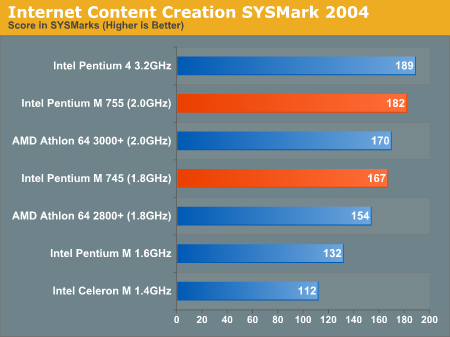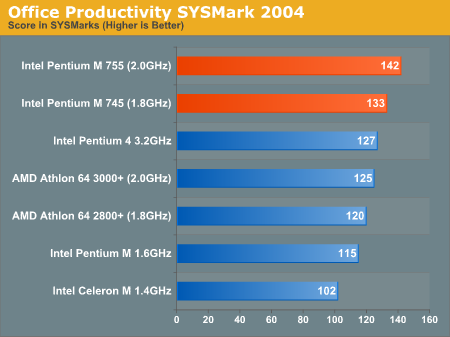Intel's 90nm Pentium M 755: Dothan Investigated
by Anand Lal Shimpi on July 21, 2004 12:05 AM EST- Posted in
- CPUs
General Usage Performance - SYSMark 2004
Like the Winstone tests, SYSMark is an important suite to look at as this is how most users will use their notebooks. Just like Winstone, SYSMark is divided into both office and content creation suites; let's have a look.This time, we look at content creation performance first. Here's what happens with the Internet Content Creation suite:
"In this scenario, the content creator creates a product-related website targeting a broadband and narrowband audience. The user first renders a 3D model to a bitmap, while preparing web pages using a web site publishing tool. The user opens a video editing package, creates a movie from several raw input movie cuts and sound cuts and starts exporting it. While waiting on this operation, the user imports the rendered image into an image-processing package, modifies it and saves the results. Back in the 3D modeling software, the user modifies a 3D model and exports it to a vector-graphics format. Once the movie is assembled, the user edits it and creates special effects using one of the modified images as input. The user extracts content from an archive. Meanwhile, he uses an animation creation tool to open the exported 3D vector graphics file. He modifies it by including other pictures and optimizes it for faster animation. The final movie with the special effects is then compressed in a format that can be broadcast over broadband Internet. The web site is given the final touches and the system is scanned for viruses."

ICC SYSMark 2004 has always favored Intel processors; more specifically, the Pentium 4. Under the older SYSMark 2002 benchmark, this was the only test where the Pentium M could not hang with its older brother. This time around, we see that the Banias based Pentium M doesn't fair well at all, but with a few architectural tweaks, twice the cache and a higher clock speed, the Pentium M 755 is nipping at the heels of the Pentium 4.
The Pentium M also manages to outperform the Athlon 64, but that is to be expected here; once again, SYSMark has always favored Intel processors.
Next, we have the Office Productivity suite:
"In this scenario, the office productivity user creates a marketing presentation and supporting documents for a new product. The user receives email containing a collection of documents in a compressed file. The user reviews his email and updates his calendar while a virus checking software scans the system. The corporate web site is viewed and the user begins creating the collateral documents. The user also accesses a database and runs some queries. A collection of documents are compressed. The queries' results are imported into a spreadsheet and used to generate graphical charts. The user then transcribes a document. Once the document has all the necessary pieces in place, the user changes it into a portable format for easy and secure distribution. The user edits and adds elements to a slide show template. Finally, the user looks at the results of his work (both the slide show and the portable document) in an Internet browser. "

Here, the Dothan based Pentium M 755 manages to outperform the Pentium 4 3.2 and the Athlon 64 3000+, both by a significant margin. Further echoing our results from Winstone, it's clear that for business users, the new Pentium M is the king of the hill when it comes to mobile computing.
The overall SYSMark graph takes both ICC and Office Productivity performance into account. For reference, we show it below:











28 Comments
View All Comments
phtbddh - Wednesday, July 21, 2004 - link
What is the battery life of a Dothan compared to a Banias? I know the Dothan is suppose to be better, but can we see some numbers?tfranzese - Wednesday, July 21, 2004 - link
Not quite SKiller, a large part of the P4's dominance in media encoding is the high core frequency attributed to such a long pipeline.SKiller - Wednesday, July 21, 2004 - link
I think the assertion that.."With Intel's vision for the future being centered on media encoding and content creation, the Pentium M is the last thing that Intel would want to build their future desktop CPUs around."
..may not be correct as by your own admission:
"Partially constrained by its 400MHz FSB and single channel memory interface, the Pentium M is not the successor to the Pentium 4 that many will make it out to be."
So all Intel would have to do is up the FSB on a desktop version to improve media encoding and content creation performance and be competitive with P4.
mkruer - Wednesday, July 21, 2004 - link
you know i wonder just how much of the preformance is gained from the 2MB of L2 cache. If I recall from Aceshardware the 2MB is the sweetspot For mico op code, any more, and there is a preformance hit in either direction, Also on a side note. The 90nm Athlon 64 show a ~5% improvement across the board.dvinnen - Wednesday, July 21, 2004 - link
Yea, I was wondering the same thing. Why not just use a mobile A64 system with a mobile 9600. Acer and emachines make systems with them.alexruiz - Wednesday, July 21, 2004 - link
Another one: Was that difficult to get an eMachines M68xx for the review? Mobile against mobile.alexruiz - Wednesday, July 21, 2004 - link
Anand made a huge mistake in the Athlon 64 CPU selection. The mobile [b]A64 3000+ is clocked at 1.8 GHz with a 1MB L2 cache[/b]. He used a desktop 2.0 GHz with 512 K. This will affect the outcome, specially because clock speed matters more cache.I knew Dotham was going to give a very good fight, but I didn't expect it to win any gaming application ot Business Winstone. As reference, my M6805 A64 3000+ scores 22.2 and 27.8 in the BW and CCMW tests (7K60 hard drive, so not the same setup)
A very good review, but we can do better. I still want to see video encoding tests run with a commercial application, preferably 3 (Ulead Video Studio 8, Roxio Videowave 7, Pinnacle 9) and 2 alternative programs for DivX encoding (DVD2AVI and virtualdubmod are suggested. We have seen enough XMPEG from other sites)
Run some photoedition benchmarks not only with Adobe, but also with Corel Photopaint 11 or Roxio Photosuite.
AutoCAD is also expected to give an idea of what be attained. SolidWorks or UG would be fantastic, but those 2 are more of a wish.
How about more scientific or technical programs? Electrical simulators (PSpice for example), FEA (Nastran), MathCAd, Maple, etc.
More games were expected to be run. Howe about chess programs? How about OSmark, the succesor of COSBI by Van Smith?
I stressed the use of 2 or more applications that do the same to highlight the fact that software optimization matters a lot and that some myth about a CPU being "the best for that activity" are only myths.
All in all, Dotham is a potent rival that uncovers some weaknesses in the K7/K8 architecture that were noticeable against the P6 (Pentium II/III) but forgotten against the P7 (Pentium 4): [b]L2 cache performance[/b] and integer performance.
Regarding battery life keep in mind that the CPU is not the biggest spender in a laptop, the screen is. The K8T800, the most popular chipset for AMF64 laptops is a desktop part, and is quite voracious. Keep those factor when battery life is evaluated.
I foresee that SOI will give AMD the edge in battery life once they implement power saving caches, the biggest energy conservation feature in the P-M.
Comments are welcome
Alex
dacaw - Wednesday, July 21, 2004 - link
Well Dothan looks very much like a copy of a 32-bit AthlonXP to me.Comparing it to an Athlon64 makes no sense. Dothan is not 64-bit.
I bought an AthlonXP Barton mobile 2600 for $99 and it runs barely warm under PowerNow. What could you buy for the price of a Dothan? Maybe 5 top-of-the-line Athlon XPs?
Let's compare apples to apples and have a review of top-of-the line Dothan to top-of-the-line AthlonXP.
Oh, and drop those fake synthetic benchmarks. What point are they if they simply "favor" Intel processors (your comment in the review).
Come on Anand, lets have a review that really means something. Please!
Jeff7181 - Wednesday, July 21, 2004 - link
Can't wait to see battery life tests.mino - Wednesday, July 21, 2004 - link
Nice review, however it is a shame you didn't include Celeron 2.4 (which could be find in many SLOW notebooks) and also AXP-M 2600+ would be nice. -> this way it would be a complete notebook market review. - The best one.I'll love to see bench results of Cely and XP added (by using same desktop platform as you did in case of P4)
mino